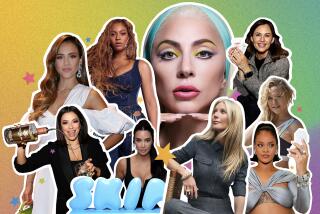Trend in Beauty Ad Campaigns: ‘Unknowns’ Becoming ‘Knowns’
- Share via
Hope Boonshaft-Lewis thinks of herself as a “real” person, not a model. But when she goes to a Germaine Monteil beauty promotion at Bullock’s next week, she won’t be shopping for skin-care products. She’ll be selling them.
And when she browses through magazines this month, she may well come across her own picture among the beauty ads.
Boonshaft-Lewis, better known as the founder of a Los Angeles-based public relations firm, says she didn’t plan to outrank every top-paid, famous-faced, undeniably gorgeous professional model in the business and take the lead in a beauty ad campaign.
Girl Next Door Has New Image
But what turns out to be most unusual about her situation is that it’s not so unusual after all. These days, when fashion and beauty advertisers say they’re searching for the girl next door, they don’t mean Debbie Reynolds. In fact, they could mean you.
This winter at Bloomingdale’s in Manhattan, Esprit, a company that makes clothes for kids, teen-agers and grown-ups, photographed thousands of shoppers, all hoping to be selected as models for the company’s newest advertisements. Those chosen will appear, along with a brief biography, in fashion magazines this spring.
It is part of Esprit’s real-people ad series, which began more than a year ago in California, and it will feature unknown faces from Los Angeles to Hong Kong in the months ahead.
At Jockey International, models for the newest branch of the business, Jockey For Her, are selected from the thousands of letters signed by average customers volunteering to bear their physical assets and their identities in underwear ads. This spring, Jockey’s male models will be selected the same way.
There is a history to the trend. Most recently, fashion and beauty ads, as well as magazine editorials, have featured sports stars, movie stars and the super rich, to promote everything from furs and cosmetics to credit cards. And outside the fashion business, more humble folk, all non-professional models, are helping sell everything from airline tickets to supermarket supplies.
But the newer twist in the national taste for glamorizing unknown faces in fashion and beauty ads takes realism one step beyond. The ads showing perfect-looking people who live fantasy lives seem to be changing.
“Fashion advertising used to depend on very high imagery,” says Sean Driscoll, who oversees Jockey for Her ads at the Warwick agency in New York.
“They used to show situations that people aspire to. Now, they’re based on real situations,” Driscoll says. (Among the women chosen for recent Jockey underwear ads are a surgeon and a realtor, with a grandmother scheduled to appear in an upcoming ad, Jockey Vice President Bill Herrmann reports.)
Driscoll attributes the change in style to a shift in the function of fashion and beauty ads.
“They used to be intended for retailers and other people in the business, so they had a very put-together, high-fashion look,” he says. “Now, they’re intended to go right to everyday consumers, sell products directly to them. And everyday consumers think about comfort, fit and color more than anything else.”
With that in mind, Esprit’s ad director, Doug Thompkins, says: “I don’t think of celebrities as real people.” And he explains, “Real people may not be absolute beauties in the media sense of the word but they have a credibility.”
Where there are trends, there are theories. But no two experts seem to agree on what this surge in realism says about modern society. Herrmann of Jockey International suggests: “I think women are doing their own thing these days and they’re very self-confident. It’s OK with them if they have less than perfect bodies. They wrote to us and asked to model.”
Thompkins of Esprit says it comes down to a desire for truth instead of illusion.
“Any company can pay $2,000 a day to hire Brooke Shields to model,” he says. “But everybody who sees the ad knows they’re being fooled. With real models we can appeal to people’s intelligence. People are tired of the pretty face. If you show an interesting face with character, beauty will come out of it.”
The bottom line is whether real faces sell products. Thompkins answers: “When we used all professional models, we received very few letters. Now we get thousands.”
Herrmann is willing to say more. Since Jockey for Her launched its real-women ad campaign last August, he says: “Business is five times what it was in 1982, our first year.”






